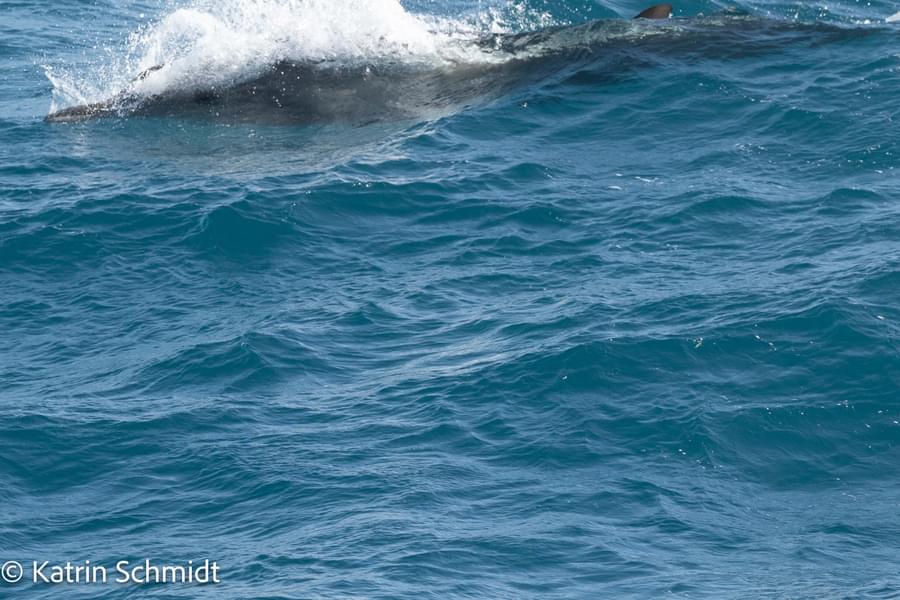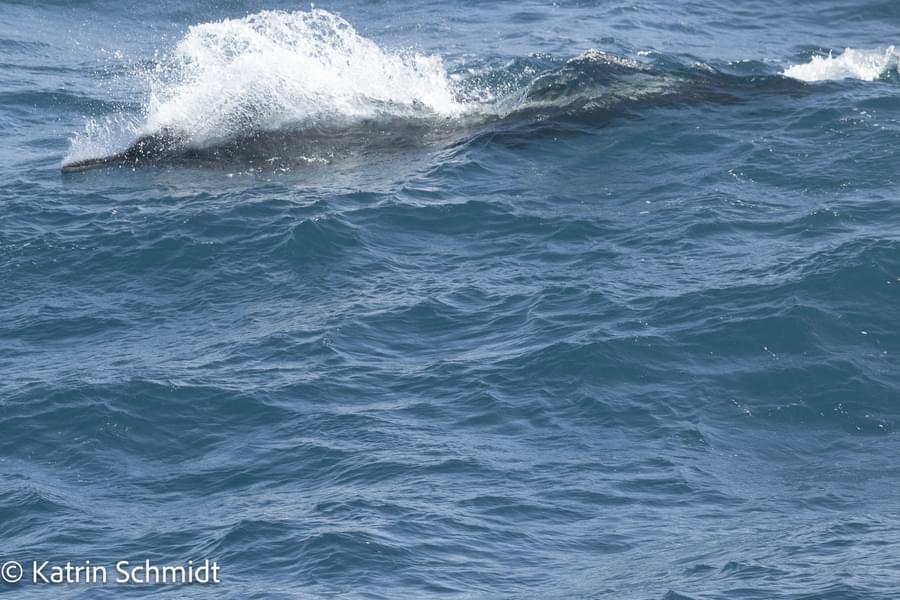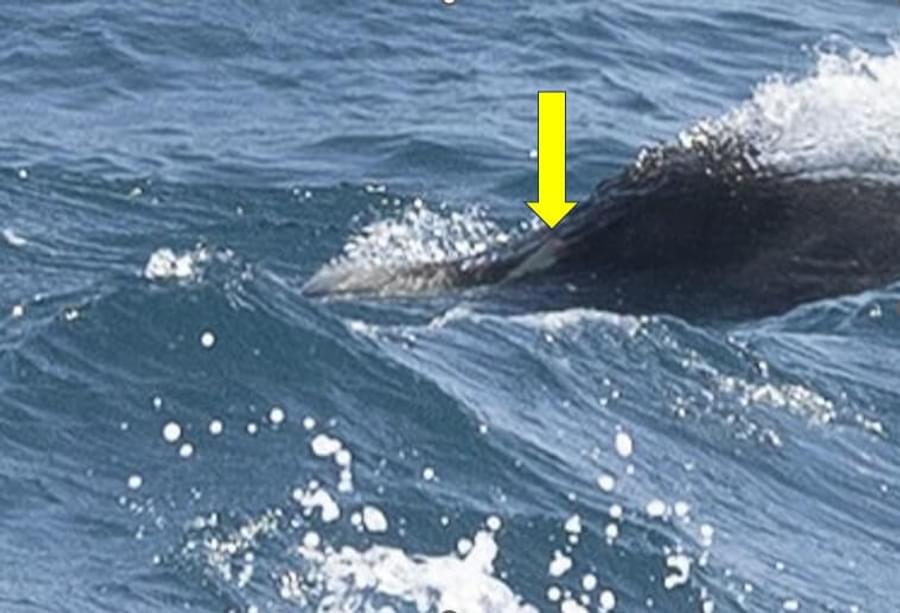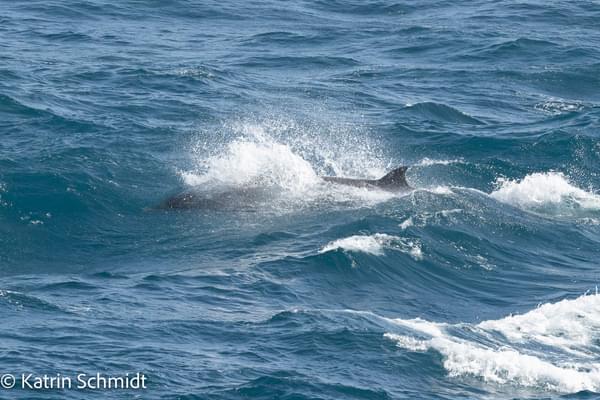The ORCA team currently in the South Atlantic Ocean had an exciting encounter with a very elusive and little studied whale this week, and one which was named by early mariners owing to an extremely unusual feature.
A team of ORCA Marine Mammal Surveyors and Ocean Conservationists on board HX’s MS Fram were sailing from the Falklands to South Georgia and had been having regular sightings of beaked whales, all of which were in groups of three. But then they spotted something rather unusual.
ORCA’s Lucy Babey, who is currently onboard the MS Fram, takes up the story:
"We had our first beaked whale sightings on 29th November, the day after leaving the Falkland Islands heading towards South Georgia. There were three sightings in total - two groups of three and then one individual. The sea was quite rough and stormy, so we could initially only establish that the animals were an unusual brown shade with a noticeable beak breaking the surface. Beyond that, identifying any other features was almost impossible. However, our curiosity was piqued to say the least.
Suddenly, two of the group of three came alongside just metres off the starboard side of the bow, surfing the waves like dolphins. And then another. This time we watched spellbound as the animal just hovered under the water ahead of the bow, like a submarine! Now we could see the distinctive dark and light patterning very clearly. The high swell and sea state in the South Atlantic made identification and photographs difficult, but the on-board Expedition Team managed to get some photographs from the short time the animals were alongside us. These clearly showed a fin and the beak, with a visible distinctive tooth on one animal - a key identification feature in beaked whales.
Our excitement was infectious, and several guests alongside us were equally enthralled by what we were seeing.
With the help of guests, we narrowed it down to Gray’s or strap-toothed beaked whales by looking through photos, listening to descriptions and reading identification books. From our ship in the Antarctic, we emailed the images to beaked whale expert Robert Pitman, who very quickly came back with a positive identification of ...(wait for it…) strap-toothed beaked whales.
Robert noted that although strap-toothed whales are the considered the most common species of beaked whale found in the South Atlantic Ocean, they are rarely observed. A presentation of the identification features and breakdown from Robert was delivered to guests on board - everyone was very excited and pleased"


The strap-toothed beaked whale (Mesoploden layardii) is one like no other – Juvenile males develop an extraordinary large, flat tusk from each lower jaw which grows at 45 degrees backwards towards its head and over its beak – rather like a reverse facing set of flat elephant tusks. This configuration means the whale is unable to open its mouth for more than a few centimetres. Puzzled seafarers quite rightly observed that the whale had teeth that looked almost exactly like a strap framing its head, and so the name has stuck.
This sighting was the first time ORCA has recorded this species – while it is not listed as endangered, it is shy and elusive and very little studied in comparison to other cetacean species, and a lot of research is largely through stranding instances.
Robert Pitman highlighted the characteristic white tip of the dorsal fin (see photograph above) which is only apparent in strap-toothed beaked whales. Some of the photographs captured also showed the long beak (see photograph above). One photo also showed the tooth evident, which is only apparent in males (see photograph below), and another photograph shows the characteristic white-tipped flukes as well.

Strap-toothed beaked whales have a distinctive and unique adult colour pattern, including a prominent cape, largely white beak, and white-tipped dorsal fin and flukes - as shown in some of the team’s pictures. This species is very rarely seen, but it is one of the few beaked whales that can be accurately identified at sea due to their dramatic and unique colouration.
The species inhabits cold temperate waters in the southern hemisphere and have been recorded around the coasts of New Zealand, Australia, Tasmania, South Africa, Namibia, the Falkland Islands, Chile, Argentina and Uruguay. They are at risk from numerous threats including entanglement and disturbance from noise, particularly that from sonar, which has been shown to cause panic, rapid ascent and subsequent death due to decompression sickness in a number of beaked whale species. This is an issue of concern given the possible future impacts of deep-sea mining exploration and exploitation. One of the key objectives of the ORCA survey team is to identify how large ships in the area can reduce their adverse impacts on whale species.
More generally beaked whales are notoriously hard to identify; firstly, they do not spend much of their time at the surface of the water, spending most of their time diving to hundreds or even thousands of metres deep to forage for squid. Secondly, some species of beaked whale can only be identified by the set of small teeth/tusks in their lower jaw which makes females near impossible to identify as they lack the teeth.
To read more about the identification of strap-toothed beaked whales, see Robert Pitman’s paper here.

The only way we can protect whales and dolphins is by understanding their distribution, and so monitoring is vital for effective conservation. Donate today to help ORCA continue to identify and study important whale hotspots around the world.

